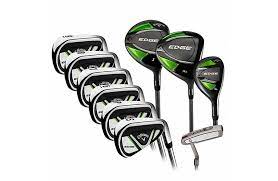Types of Golf Clubs – A beginners guide
This article will be a very baseline introduction to every different types of club in a standard golf bag. During a round of golf we will be faced with shots of various distances, long and short. The rules of golf permit us to use a maximum of 14 clubs. A set can be made up of any combination of your choosing, suited to your personal preferences. This would normally include a driver, fairway woods , hybrid, irons, wedges and a putter. If you do not have any knowledge about the sport of golf, this article is a great introduction for you. Stay tuned for more information about the different types of golf clubs.
Driver
It is fitting to begin with a driver, since that is what will be used to tee off for a majority of the holes in golf. For most golfers a driver will have a loft of 8.5 to 12.5 degrees. The average being either 9.5 or 10.5 degrees. Loft is an important term for this article, and it is the angle of which the face of the club has off perpendicular to the ground. For these purposes, zero degrees of loft is a club face perfectly perpendicular to the ground when being held by a golfer. The driver has the longest length shaft, combined with the lowest loft angle combining to create the most distance of all your shots.
It is also the most difficult club to master in my opinion, since it has the widest area on the face, making for the widest room for error. Overall, the driver is the longest and most important club in the bag. ‘Teeing off’ successfully by by creating good distance and keeping your ball in play are keys to scoring well.
Fairway woods
Woods are used to hit long shots. If a golf hole is 450 yards from tee to green, most golfers use a wood to hit off the tee. A wood is a hollow-bodied large headed golf club. It’s customary to use your woods when you are 175 yards or more away from the green.
Most golfers also carry 3 and 5 woods in their bag. A 3 wood has a loft between 13 and 16 degrees, and a 5 wood has a loft between 19 and 19 degrees. The higher the golf club number, the higher the loft. Also, the higher the golf club number, the shorter the club shaft length. The 3 wood and 5 wood are commonly referred to as fairway woods, because they are most often used during the second shot of play, when you are supposed to be in the fairway of the golf hole (as opposed to in the woods!). All higher lofted woods (7, 9, 11, and so on) are commonly referred to as utility woods. A 3 wood is generally 1” shorter than a driver and so on with each successive club.
What about 2 and 4 woods? These woods actually exist and were popular 20 or more years ago. However, they have fallen out of favor as newer technologies have improved the performance of woods. Today, most golfers prefer 7 and 9 woods in their bag (which can only have fourteen clubs) than a 2 or 4 wood. In fact, there is now a trend to include higher numbered woods and eliminate the traditional low numbered irons in your set of golf clubs. That will be discussed in greater detail when we talk about irons.
Woods made of metal?
Why aren’t woods made of wood? They used to be, but since the 1980’s woods have been made of metal. Metal has many advantages over wood. For the beginning golfer, the most important features are perimiter weighting and low centre of gravity (LCG) which can only be achieved through precisely molded metal. Both of these design technologies result in golf clubs that are much more forgiving than wooden woods. Perimeter weighting helps create a larger sweet spot. A larger area on the face of the club that will result in a good hit. Low center of gravity creates mass at the right place. This will increase the height that the ball will launch off the club and reducing the likelihood of miss-hits into the ground.
Fairway woods vs long irons
Many people would rather hit a high-lofted wood into a green than a 2, 3 or 4-iron. In which case 3, 4 and 5 woods and even higher are what you’re after. The larger club head of a fairway wood compared to an iron makes it easier to achieve more distance more often. As a rough rule of thumb, a 4 wood would replace a 2-iron, a 5 wood the 3-iron, a 7 wood the 4-iron and a 9 wood the 5 iron.
Hybrids
In the past 5 years a recent development that began over 10 years ago has really caught on with pros and non-pros alike. Hybrids are a combination of a fairway wood head design and a iron length shaft. The long irons have traditionally been the most difficult to hit. Evidence of this difficulty was best captured by Lee Trevino, who said, “if you are ever caught on a golf course during a storm and are afraid of lightning, hold up a 1-iron, not even God can hit a 1-iron.” The idea is to give the golfer a more forgiving option when compared to long irons, which are more difficult to hit. Hybrids are commonly touted as “the best of both worlds. The popularity of hybrids has been so strong in recent years that many golfers have decided to replace many of their 3 and 4 irons with the hybrid clubs.
An important factor is the distance that many hybrids offer when compared to a typical 3 or 4 iron shot. You will also see golfers opt out from using 5 woods and 7 woods, replacing those fairway woods with a #2 or #3 hybrid. It is important to remember that while most manufacturers match the hybrid number to the corresponding iron number, the best indicator of distance when looking at hybrids is the loft. Most 3 hybrids match up closely with a 3 iron in loft. Loft being equal, most hybrids will perform better with regards to distance and forgiveness.
Irons
Next are irons, which are the most commonly used types of golf cubs . This is the standard club you imagine when you think about golf. It looks like a metal sliver, but it is used to strike the ball in any sort of grass. There are irons from two to nine, but most players have four to nine irons. The number on the iron is associated with the loft and length of the club.
As the loft changes by 3 to 4 degrees per club, so to will the length of the shaft by half an inch . To be clear, a nine iron has the most loft, the shortest shaft and subsequently the least distance. Therefore the lower the number on the iron means it goes the further distance. That can be quite confusing for beginners, but it can have a great effect on your game. In summary, an iron is the most popular club in a golf bag and therefore it is used most often.
Wedges
These clubs are used closer to the hole. Wedges are similar to irons but have much higher loft to get the ball high into the air and go a little distance. This allows for great control on the ball. We would generally play most of our chip shots up to 35 yards and our pitch shots 35 – 85 yards with these clubs.
The first wedge is the pitching wedge (PW), which is usually about 46-48 degrees in loft. Wedges generally increase in increments of 4 degrees loft. So wedges commonly come in 48, 52, 56, 60 and 64 degree lofts. The PW is the lowest loft of the wedges. Following the PW with higher lofts are the Approach Wedge (AW), Sand Wedge (SW) and Lob Wedge (LW).
Putter
A putter is used on the green close to the edge of the green and is the final club used on every hole. It is the shortest in the length and has very little loft angle on the club face. A putter is designed to roll your ball along the green. You are guaranteed to putt on every hole, unless you chip in which is quite rare. There are many different types of putters each with their own special features which is too much for us to discuss today. But of all the different types of golf clubs this is the one that requires the most attention.
Just remember that a putter can account for anywhere from 35 – 55% of your total shots and is often the key to scoring well. So choose it wisely and practice, practice, practice.
Summary
Deciding on 14 clubs can be a confusing endeavor with so many options out there. The only two clubs we know we need is a putter and a driver. How do we decide on all the clubs in between? This really depends on club head speed and how far you carry your clubs. In general, if you are lower in club head speed you should have fewer irons and more hybrids and fairway woods. If you are higher in club head speed you should have more irons and maybe only 1 hybrid and 1 fairway wood. Your consistency of contact also plays a role in your deciding how to make up your set.
Traditional set make up Modern set make up
Driver Driver
3 & 5 fairway Woods 3 fairway wood
3,4,5,6,7,8,9 irons 3 & 4 Hybrids
PW, SW 5,6,7,8,9 Irons
Putter AW,PW,SW,LW
Putter
With every club comes different alterations, fitting and repairs that may be necessary. However at Killarney Golf Academy we will walk you through all of these different options and optimize all types of Golf Clubs for you to guarantee the best performance possible when you get out on the course. Trust in us for all of your Custom Fitting and golf club alteration needs, we will get the job done for you guaranteed!
Mark Heinemann
PGA Professional Killarney Golf Academy & Getgolfing.ie
Email – getgolfing.ie@gmail.com 
Phone – 087 2209663
Facebook – Killarney Golf Academy Mark Heinemann PGA
Youtube – Mark Heinemann PGA
Instagram – markheinemannpga
Types of Golf Clubs
Killarney Driving Range


